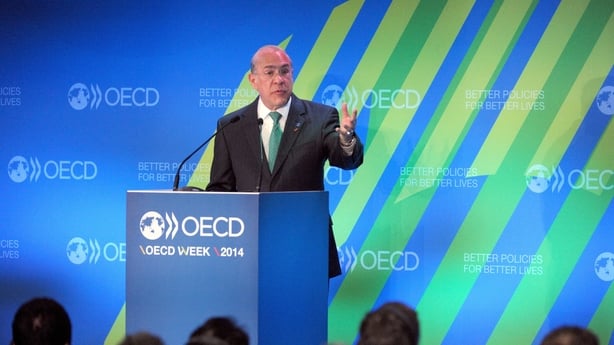The Organisation for Economic Co-operation and Development has said that Ireland's economy is set to grow at a more sustainable pace this year and next, after very strong expansion over the past two years.
But in its latest economic forecast, the Paris-based OECD said the sharp rise in house prices and lending raises concerns that another house price bubble may be forming.
It noted that while activity in the construction sector is gaining momentum, supply is expected to fall short of demand for some time.
"The authorities should stand ready to tighten prudential regulations if needed," the OECD cautioned.
The OECD also said that as the Irish labour market tightens, wage pressures will continue to be strong, which will feed into higher inflation.
It also said that the country's banking system is still impaired and noted that non-performing loans still account for around 17% of total outstanding loans - the majority of which are property-related.
The OECD said that given elevated uncertainties - including Brexit - economic policies should firmly focus on underpinning stability and making the economy resilient against shocks.
It also said the high level of private indebtedness leaves the country "sensitive" to a rise in interest rates.
"A rise in protectionism would be particularly detrimental to the Irish economy given its high degree of openness," the OECD said.
Meanwhile, the OECD said that the global economy is on course this year for its fastest growth in six years as a rebound in trade helps offset a weaker outlook in the US.
The global economy is set to grow 3.5% this year before nudging up to 3.6% in 2018, the Organisation for Economic Cooperation and Development said.
That estimate for 2017 was not only a slight improvement from its last estimate in March for 3.3% growth, but it would also be the best performance since 2011.
Yet despite this brighter outlook, growth would nonetheless fall disappointingly short of rates seen before the 2008-2009 financial crisis, OECD Secretary General Angel Gurria said.

"Everything is relative. What I would not like us to do is celebrate the fact that we're moving from very bad to mediocre," Gurria said.
"It doesn't mean that we have to get used to it or live with it. We have to continue to strive to do better," he added.
While recovering trade and investment flows were supporting the improving economic outlook, Gurria said barriers in the form of protectionism and regulations needed to be lifted to ensure stronger growth.
The improvement would also not be enough to satisfy people's expectations for better standards of living and reduce growing income inequality, he said.
The OECD saw an improved global outlook even though it downgraded its estimates for the US, despite a weaker dollar boosting exports and tax cuts supporting household spending and business investment.
The OECD forecast US growth of 2.1% this year and 2.4% next year, down from estimates in March of 2.4%and 2.8%, respectively.
The OECD's chief economist Catherine Mann attributed the downgraded outlook to delays in the Trump administration pushing ahead with planned tax cuts and infrastructure spending.
The weaker US outlook was offset by slightly improved perspectives for the euro zone, Japan and China.
Boosted by firmer German growth, the euro zone economy was seen growing 1.8% both this and next year, up from 1.6% for both years.
Lifted by improving international trade in Asia and fiscal stimulus, Japanese growth was seen at 1.4% this year before slowing to 1% next year, both slightly raised from the OECD's March estimates of 1.2% and 0.8% respectively.
The OECD also marginally nudged up its estimates for growth in China to 6.6% this year and 6.4% in 2018, boosted by stimulus spending.

That in turn was supporting strong imports and helping to fuel a revival in Asian trade. As a result, global trade volumes were seen growing 4.6% this year, nearly double the rate seen in 2016.
On risks, the OECD warned that the growing divergence between monetary policy rates among the major central banks raised the chances for financial market volatility.
The OECD also saw a potential for "swift snap-back" in US long-term interest rates when the Federal Reserve decides to reduce the size of its balance sheet, especially if it comes at a time of rising policy rates.

